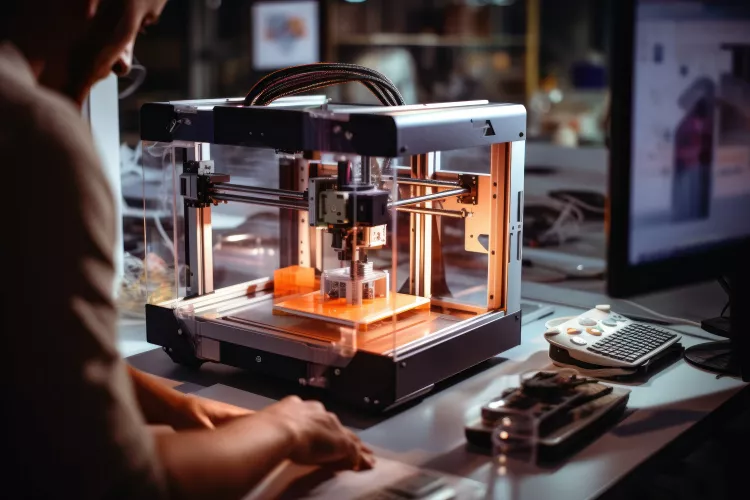CANADIAN IMMIGRATION UPDATES: Applicants to Master’s and Doctoral degrees are not affected by the recently announced cap on study permits. Read more

3D printing and generative design spurred massive COVID pivots: UBC study

At the start of the COVID pandemic, many people were holed up at home binging Netflix, baking sourdough and learning the finer points of Zoom meetings. But innovative manufacturers and makers groups around the world were doing something very different: using 3D printing and generative design to fill a dire need for masks, swabs, ventilator components and other medical equipment.
Now that remarkable pivot, and the stages that followed, are the subject of a new study from the UBC Sauder School of Business.
For the study, titled The Role of Generative Design and Additive Manufacturing Capabilities in Developing Human-AI symbiosis: Evidence from Multiple Case Studies, researchers identified 48 European and U.S.-based manufacturing businesses — among them automotive, aerospace, military, medical, consumer goods companies and more — that pivoted their operations during the pandemic.
The researchers then interviewed supply chain managers, technology managers, engineers and other leaders from those companies at three different points: from May to July 2020, when COVID-19 was taking hold globally; November 2020 to January 2021, as the pandemic shock evolved; and July 2022 to November 2022, when the COVID emergency had mostly passed.
They found the companies that were more successful in pivoting had ramped up their additive manufacturing — also known as 3D printing — which allowed them to make enormous leaps. For example, shoe brand New Balance switched its production lines from sport shoes to face masks and other personal protective equipment, or PPE, for a local hospital.
“Using standard manufacturing processes, it's very difficult for companies to move from one product to another, and it can be very expensive — new equipment, new machines, new production lines,” says Samuel Roscoe, an additive manufacturing expert and UBC Sauder lecturer who co-authored the study with Elliot Bendoly, Aravind Chandrasekaran and Mateus Ferreira Lima from Ohio State University, Robert Handfield from North Carolina State University and Siavash H. Khajavi from Aalto University.
“But with 3D printing, you can just change the design, enter that new design into a machine, and begin spitting out different types of products. So it gives you this element of flexibility — and the pandemic encouraged that novel thinking.”
Roscoe says the companies that had the most success with 3D printing also used generative design — so instead of only using human designers to create plans for new products, they used artificial intelligence to generate optimal designs.
“Generative design forces designers to think about products, and the way products are used. It suggests different combinations of materials, different uses of materials, and different ways a particular product could be put together,” says Roscoe. “Designers alone are more limited when looking at new products and new markets because they don't have that experience.”
While many of the companies were large national or multinational businesses, their location and nearby medical needs were what really spurred innovation.
“During the pandemic, a big driver of the pivoting was proximal demand — for example when the company was located close to a hospital or medical facility that urgently needed thing like nasal swabs.” says Roscoe. “It was really driven by local relationships, which is not something you think about with big multinational companies.”
But it wasn’t all smooth sailing for manufacturers who were keen on taking a different tack — in particular because countries often have tough regulations around manufacturing processes, certification and distribution, especially when it comes to medical equipment.
“Some of these companies wanted to pivot to making ventilators, so they spoke with doctors, designed the equipment and manufactured it,” explains Roscoe. “But when they went to introduce it to hospitals, they couldn’t because they didn’t have the regulatory certification.”
What’s more, with the field of 3D printing growing so rapidly, industry standards haven’t yet emerged, so materials and techniques vary widely. Additive manufacturing equipment is also limited in terms of size and speed.
“You can’t make products as quickly as you would on a normal production line, so that’s a limitation,” says Roscoe. Cost is another major constraint, he adds. “The technology is expensive, and you need to have designers and software engineers with a sophisticated understanding of that technology in order to employ it.”
Looking back at the pandemic stages, Roscoe says companies scrambled at first, then determined what was possible, then worked with the technology — to the point where by late 2020 and early 2021, it was embedded in their operations. Now additive manufacturing and generative design are simply part of their everyday practices.
“Companies that have been constrained for so long by conventional manufacturing techniques now have technology that frees up the design space, and allows them to come up with completely novel designs — and the generative design is moving that even further,” says Roscoe, who adds that collectives like America Makes — which brings together experts from industry, academia, government, economic development organizations and others — have been essential in driving the rapid rise of additive manufacturing and generative design.
“This really is the future of manufacturing, and where fields like automotive, aerospace and high-end medical equipment are going now. So it’s quite significant.”